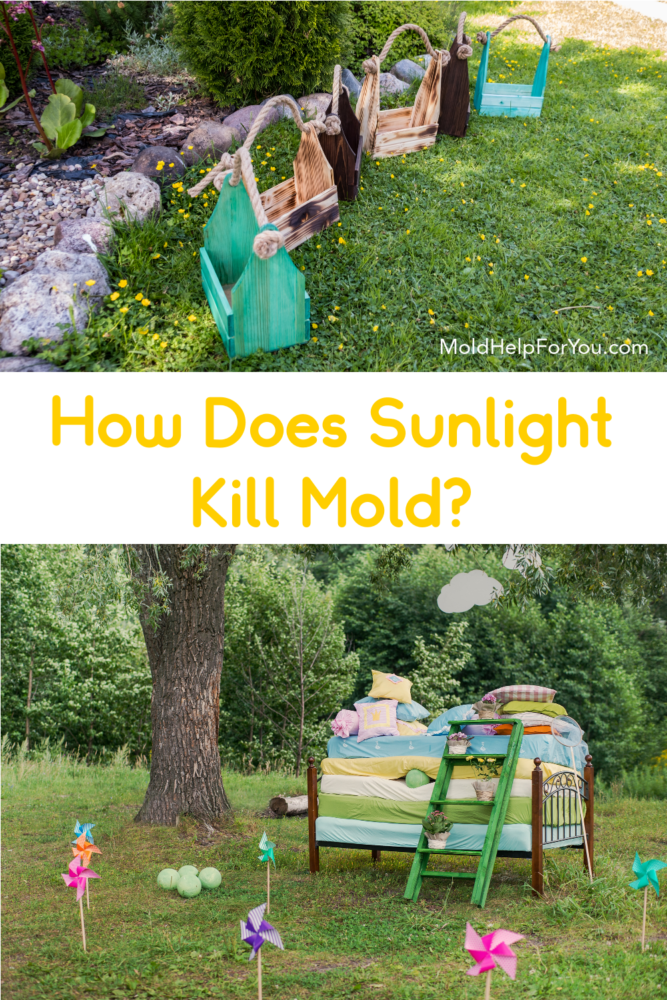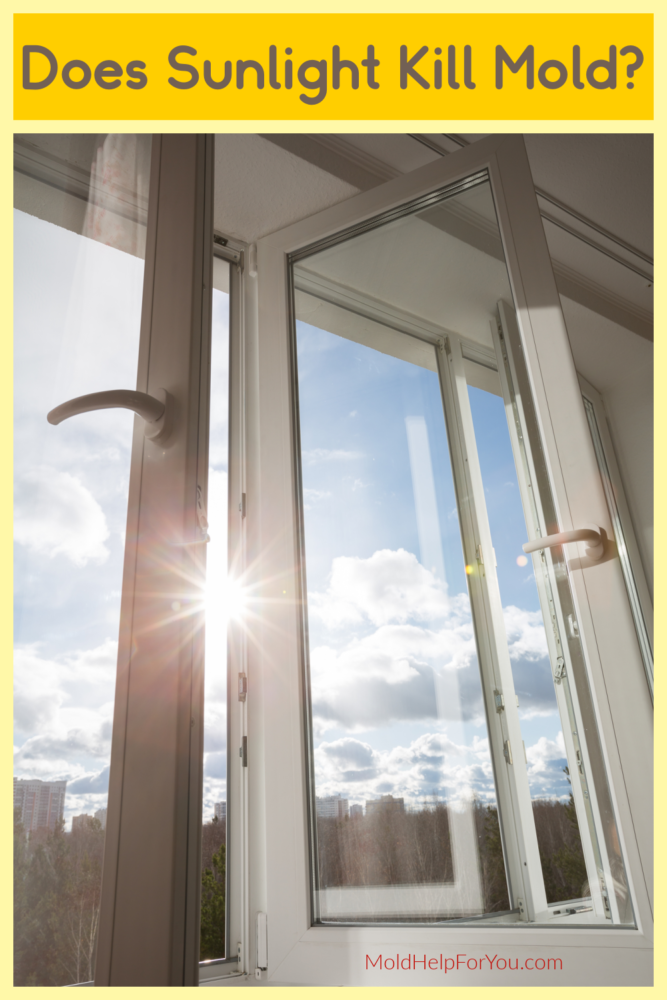Does Sunlight Kill Mold?
This post may contain affiliate links. Read our full disclosure.
One of the most frequently asked questions I get when I am on a consultation call with someone who is determining what mold contaminated items can be saved is “does sunlight kill mold?” The reasoning behind the question typically stems from the logic that you don’t see outdoor mold growing out of control everywhere so something must be preventing it from growing or slowing the rate of growth.
We know that mold typically needs moisture or another food source to grow. We know it needs oxygen. We know it is happiest at warmer temperatures. And we know that mold prefers dark places but won’t shy away from light and bright if other conditions are met. So it does stand to reason that sunlight isn’t mold’s most favorite thing. While outdoor mold can be a big issue due to the never-ending supply of moisture and food, it can be argued that it is kept in check by the sun.
Let’s take a deeper dive into sunlight and mold. I think you might be surprised at the real relationship between these two.

How Does Sunlight Kill Mold?
You probably have heard of Ultraviolet (UV) rays which are produced by the sun. These are those pesky rays that you get warned about. But they do have some very good qualities as well.
UV-C is a very short length of UV light. One of it’s superpowers is producing radiation that destroys fungal cells. It kills mold and other bacteria by penetrating the organism’s cells and damaging the DNA within. More specifically, UV-C rays work by disrupting the nuclei of microorganisms.
Once a mold spore’s DNA is damaged it can no longer reproduce. So instead of spreading or perpetuating itself, the mold cell eventually dies.
Although there is outdoor mold, the UV-C rays control mold concentrations which is why it doesn’t grow literally everywhere outside.
How Quickly Does Sunlight Kill Mold?
With direct exposure to the sun’s ultraviolet light, it takes 1-3 hours to damage a mold spore’s DNA and stop it from reproducing.
Does Indirect Sunlight Kill Mold?
No. It’s as simple as that. Window glass and cloud cover filter out UV light and therefore the sun coming through will have little to no impact on mold.
Are There Disadvantages To Using Sunlight To Kill Mold?
- First, sunlight is not a replacement for remediation and mold removal. If you have a mold issue in your home, there is no way of fixing it with the sun.
- While the sun may indeed render mold spores unable to replicate, it won’t remove the mold or mold spores from whatever item you have basking in the sun. You still need to remove as much mold from the item first and then allow it to get some sun.
- The sun can only impact visible mold. The light has to actually reach the mold for it to have any type of effect. If mold is growing from the inside out, the sunlight will not be able to reach all of the mold spores, only those on the surface of the object.
- If the moldy object is coated in dust or debris, it can also greatly lower the sun’s UV rays from reaching the mold spores.
- Trichothecenes resist sunlight. Trichothecenes are just one variety of mycotoxins. The concern with this is if you have a highly contaminated environment and are relying on just the sun to clean your items, you may be leaving behind an untold number of health damaging mycotoxins.
Is It Worth It To Use Sunlight To Kill Mold On Items?
If you have an item with surface mold, there is a pretty good chance that after you properly clean off the mold that the sunlight will prevent any mold from returning. So direct sunlight for 3 hours will likely tackle any mold spores that were inadvertently left behind on an object after a mold removal protocol was followed.
The types of items that tend to have the most success in the sun are:
- Freshly washed clothes, towels, sheets, and other thin fabric items
- Plastic items
- Leather items (be careful as sunlight can bleach leather)
- Houseplants
- Some wood items although this can be tricky since mold really loves to root deep into wood
Remember – anything you decide to set in the sun should have all visible mold removed first.
As a mold professional I personally would not rely solely on the sunlight to kill mold. But it is a great compliment to other mold removal techniques.

Sources:

Hello,
Thank you for all the info. I am reading 1-2 articles everyday since last week. And getting really annoyed bu realising mold everywhere afterwards 🙁
I was wondering; does heat kills mold? When i realized i have mold on the end of my wood cutting board first i ve used sandpaper to clean it and then heated/burnt it with a lighter.
And now im wondering if its ok to use or not..
Hi there! The issue with wooden cutting boards is that typically, if you can see mold, the mold has already rooted deeper into the cutting board where you can’t see. It makes it very difficult to remove all of the mold. If you have a moldy cutting board, my advice is to always dispose of it.
thank you! when it comes to wood- if its already covered with oil (either synthetic for floors or natural like tung oil for cutting boards) then it gets moldy- does it still mean it penetrated inside despite the oil coverage?
Hi,
Just wondering if you could give us some advice on how to successfully remove mildew from household items. We had a bunch of stuff stored in the basement of our rental unit. Dog and cat beds, blankets, towels, furniture, tent, garage items (as we did not have enough room to store them in the garage), mirrors, weights, a table, a mattress. Is there anyway to salvage all of these items? I just placed most of these in the sun. Still need to clean some off. Not sure how to correctly do this without wrecking them. I have read a mixture of vinegar and water. Not sure what to do, though. Any advice you could provide would be appreciated.
Also, the issue with the basement is that the house is old and water comes in cracks. We do clean it up to the best of our ability but cannot get at all of it.
Hi Dustin. Porous items are tricky. A mattress cannot be safely cleaned unfortunately. I don’t really have a suggestion for you on that.
Anything that can go in a washing machine can be laundered with this: https://www.citrisafe.com/product/remedy-laundry-liquid-detergent-32-oz/?wpam_id=65
The other items you mentioned can be cleaned with this: https://www.amazon.com/Superstratum-Mildew-Stain-Remover-32-ounce/dp/B095J4QSNG?tag=moldhelp-20&ref_=as_li_ss_tl Spray it on, leave it for ten minutes, spray again and wipe clean.
Do you have a dehumidifier in the basement to help deal with the increased moisture levels?
I live in Hawaii and have a very stubborn mold issue in my car. It grows on both the leather seats and plastic pieces. I use a product that is supposed to kill and control the growth of mold, but it always comes back after a few weeks. Any recommendations on products and strategies to exterminate this mold? I greatly appreciate your time and any info you are willing to share! Mahalo!
Hi Rob! Yes, you will need to do a chlorine dioxide bomb! I will send you an email with more information.
Can you please advise how to get mold and mildew out my car. It has been cleaned by pro, but still smells moldy. I have had lung cancer twice and I’m concerned about riding in the car. Is there any way to de-mold the car to the point that I am not afraid to ride in it. It stinks like mold and mildew to me. My husband thinks it is strong chemical cleaning agents I might be smelling.
Hi Shannon! Here is a link to my article on car mold: https://moldhelpforyou.com/car-mold/ This should answer all your questions!